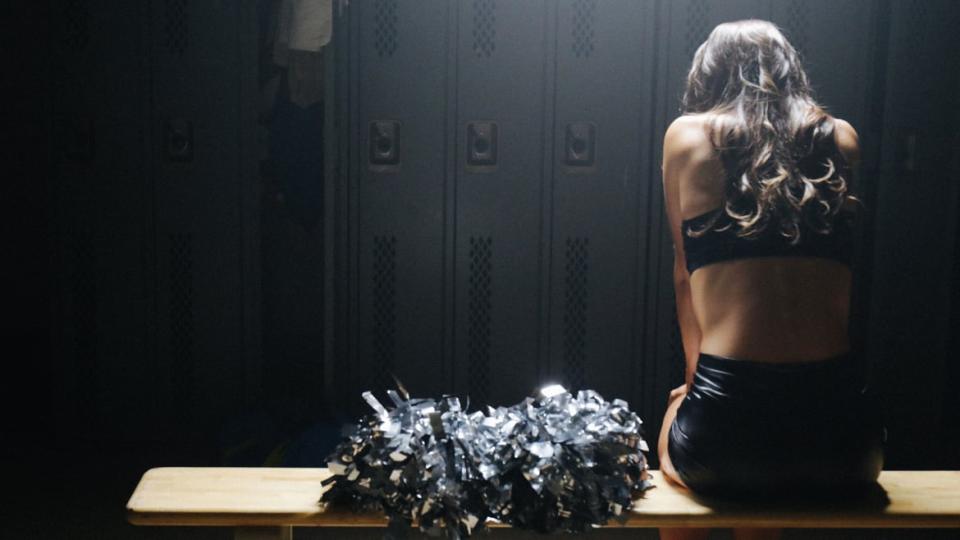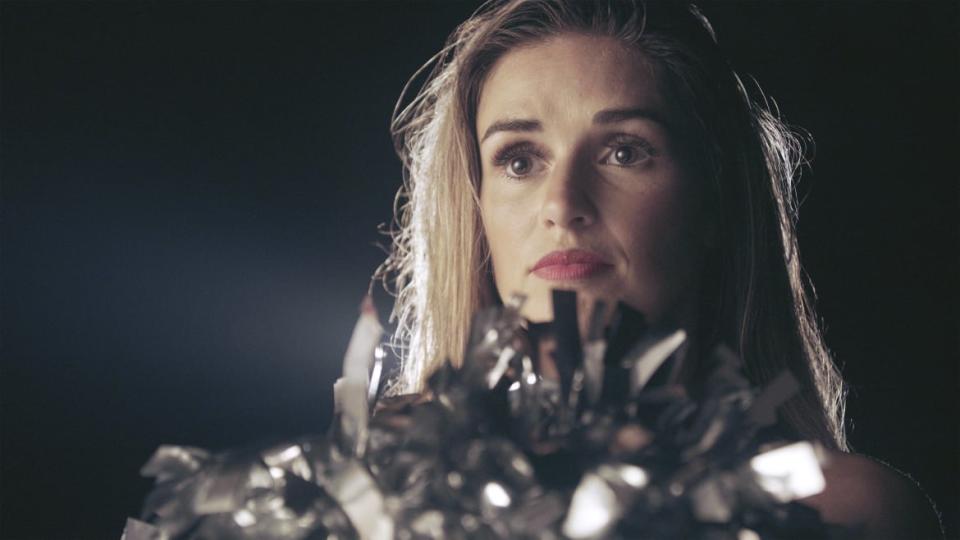The Dangerous Lives of NFL Cheerleaders

A professional cheerleader in the NFL should feel lucky just to dance on the sidelines—she’s reminded of that, and of her own replaceability, all the time.
When Lacy Thibodeaux-Fields joined the Oakland Raiderettes in 2013, she followed the rules spelled out in her contract and the team handbook. If she gained more than four pounds, she learned, she might be benched from a game without pay. If she was late to a public appearance or brought the wrong equipment, she was subject to fines ranging from $10 to $125. The list of potential infractions went on: A teammate, she recalled in 2014, once got Sharpie on her uniform at a signing; she was forced to reimburse the team for the expensive garment herself.
“Lacy T.,” as Thibodeaux-Fields was christened while on the team, was instructed to color and style her hair specifically like Rachel McAdams. She paid for those visits to Raiderette-approved hair salons, as well as for her elaborate makeup, French-tip mani and pedicures, and artificial tans—all mandatory for public events—out of her own pocket. For nine months of mandatory thrice-weekly practice sessions, minicamps, public appearances, photo shoots, home games, and the surrender of all rights to her image, she was paid just once: $1,250 at the end of the season. Team mascots and stadium concession stand workers earned more; they at least made minimum wage.
Thibodeaux-Fields, a driven and (of course) peppy Louisiana native, lifelong dancer, and young mother and wife, became the first Raiderette in the cheerleading squad’s then 53-year history to demand more. She filed a class-action lawsuit against the Oakland Raiders in 2014, alleging wage theft and unfair employment practices.
The Incredible True Story Behind Dolly Parton’s ‘9 to 5’
Her suit spurred NFL cheerleaders in cities across America, including Buffalo, Cincinnati, Tampa Bay, and New York, to speak out and sue their teams for compensation for their own unpaid work. Thibodeaux-Fields sparked a movement. But like so many real-life feminist stories, this one is unfinished and its few victories are bittersweet. Many of those teams’ suits are still pending. The (now Las Vegas) Raiderettes succeeded in wresting a $1.25 million settlement and now earn minimum wage. But that’s paltry pay for the lifetime of training and athletic talent it takes to be a professional cheerleader, let alone the branding and publicity their work brings to an $11 billion-a-year industry.
Director and cinematographer Yu Gu’s documentary A Woman’s Work: The NFL’s Cheerleader Problem (first aired on PBS, now available on VOD) follows Thibodeaux-Fields and former Buffalo Bills cheerleader Maria Pinzone in the months and years after each filed lawsuits against their teams. It’s an affecting portrait of how we undervalue “women’s work,” both in female-fronted careers like cheerleading and in the labor of homekeeping. At just under an hour long, it is precise and purposeful in every interview and event it depicts. And it efficiently captures the complexity of women’s views about their own worth.
Gu focuses throughout the film on humanizing her protagonists, highlighting their individuality in defiance of an organization that demands they all look the same. We get to know their families and childhoods, witness their staggering athleticism, and watch them struggle through the challenges of their home lives, too. In contrast to the sequined, stadium-lit glamor in which these women usually appear, Gu employs only soft, natural light when they’re on camera. The effect recalls an archival image we glimpse at one point of a football player holding a sign during the 1974 players’ strike. It read, “Players are people, not property.” So too are these cheerleaders.
In the cheerleaders’ fight for fair pay, the film finds a microcosm of the dynamics that have shaped women’s perceived value not just in the American workplace, but everywhere else, too.
Gu ventures into tailgates where young men in Buffalo Bills regalia declare that “nobody cares about the Jills” and that “all they do is tramp themselves out for drunk guys.” Female fans seem hesitant to voice support. One tells the camera she doesn’t “agree with the image that a lot of these NFL cheerleaders are portraying,” a valid criticism of beauty standards leveled at the wrong targets. (The cheerleaders aren’t fining themselves for gaining weight.)
But the film’s greatest strength is how deftly Gu finds unexpected nuances, grace notes, and ironies in these cheerleaders’ stories. Each hits like a sledgehammer—all the more powerful for how understated the film’s argument is.
We watch the Buffalo “Jills” dance on the field in pink to raise awareness for breast cancer, for instance, and later watch Niagara Falls light up in pink during one of their required charity appearances. Then, without warning or theatricality, we watch as Pinzone crumples in her car, heartbroken. Her mother has passed away just a month before her wedding. She lost her to breast cancer. (Pinzone’s suit against the Buffalo Bills for back pay, also filed in 2014, has weathered delay after delay and is still ongoing.)
Ex-NFL cheerleaders who feel “betrayed” by the lawsuits are not excluded. We briefly attend a Las Vegas reunion of ex-Raiderettes. Some are now in their 40s and 50s; none arrive without stadium-windswept blowouts. All are fiercely protective of the elite sisterhood of former NFL cheerleaders. All are fiercely protective of the elite sisterhood that comes with having been an NFL cheerleader. “I felt sorry for these girls bringing it forward because they’re not getting the bigger picture,” one intones with a bless-their-heart sanctity. Another openly sobs through her testimonial: “I never asked to be reimbursed,” she says, scandalized at the thought.
It’s easy to roll your eyes at them. The images of this sorority of ex-Raiderettes—some of whom went so far as to shun and intimidate the cheerleaders pressing lawsuits; most of whom are white; all of whom traveled to Las Vegas and arrived in full hair and makeup just to spend time with one another—prompts an unspoken assumption: A lot of these women probably have money. Still, the bonds they formed while in uniform and their love for one another do feel genuine. Their time onscreen shows us what the cheerleaders who broke ranks have lost.
Thibodeaux-Fields grew up without much money in rural Louisiana. She felt embarrassed by her parents’ poverty and of how she “always smelled like cigarette smoke” as a teenager. Dance was a literal escape; no one knew which house she’d grown up in when she was onstage. In an early scene, her mother and father, sitting in their yard with a rusted fence, gush earnestly about their daughter. Her talent, gumption, and independence—they’re finishing each other’s sentences with the rapport of decades-long best friends.

Lacy Thibodeaux-Fields
They get to the part of the story where Lacy packs up for San Francisco and somehow makes it into the NFL. “It would be like our son was playing on an NFL team, it’s the same thing,” her mother beams. Thibodeaux-Fields’ father stops suddenly. He tilts his head and ventures, “I don’t know, that would be totally different.” They bicker for a moment. He insists, but her mom stays firm: “If we had a son and he played NFL football, it would be an amazing thing.” Thibodeaux-Fields’ father sits quietly.
Thibodeaux-Fields sacrificed her cheerleading career to speak out against the NFL’s exploitation. She sparked the first measures of change in an impossibly powerful industry. But she shares her most pressing frustrations these days with many young moms.
All day long, she’s serving someone else—often her two small daughters, who already love to dance. More than once, we see how it falls on her to keep her husband engaged when it’s his turn to watch them. She practices dance moves while sitting in the living room, her youngest clawing all over her. Her other daughter is in bed, where her dad is supposed to read her a story. The camera glances quickly through the doorway. He’s clacking away on his laptop.
Now 34, she teaches children’s dance in a small, sunny studio in Florida. Her students’ little arms and legs mimic hers at a recital. She’s dancing along behind their parents, radiant with a brilliant smile. It never budges or falters—that’s part of what she taught them—yet it never looks less than authentic either. It’s the same grin we see when she laughs in her backyard, delighting in her husband’s firecrackers as her baby screams on her shoulder. She can smile through anything. It’s a million-dollar skill.
Get our top stories in your inbox every day. Sign up now!
Daily Beast Membership: Beast Inside goes deeper on the stories that matter to you. Learn more.

 Yahoo Sport
Yahoo Sport 





































